Interpretation of the Bitcoin holdings of institutional investors in 2024: What important information is revealed in the 13F document?

Reprinted from panewslab
02/24/2025·2MAuthor: @samcallah
Compilation: Vernacular Blockchain

I reviewed the 13F file and according to my statistics, there were 1,573 institutions holding long positions in Bitcoin in the fourth quarter of 2024.
These institutions include banks, hedge funds, registered investment advisors (RIAs), family offices, endowments, pensions, sovereign wealth funds and other asset management companies. Here are some of the main findings:
1. What is a 13F file?
Before going into the deeper, I would like to clarify what the 13F file is. Each quarter, large investment companies with assets under management of more than $100 million must file 13F documents with the Securities and Exchange Commission (SEC) to disclose their holdings of U.S. stocks and stock-related assets, such as ETFs and REITs (Real Estate Investment Trusts) , options and convertible bonds.
It should be noted that the 13F document only contains long positions of institutions on U.S. stocks and stock-related assets.
Therefore, it does not include the following assets: bonds, real estate, commodities, precious metals, raised investments (such as hedge funds, venture capital, etc.), futures, spot Bitcoin, cash, foreign stocks/currencies, and short positions.
Therefore, the 13F document cannot fully reflect the organization's overall investment portfolio.
We cannot know the proportion of the institution's holdings in other asset classes, nor can we determine whether a long position is used only to hedge short positions elsewhere.
I emphasize this because next I will discuss the size of Bitcoin holdings in these 13F files. But please note that these data only reflect the institutional allocation in U.S. stocks and related assets.
In fact, these institutions may have smaller bitcoin holdings than those shown in the report, provided they are also invested in other asset classes.
A good example is the recent disclosure of its $IBIT (iShares Bitcoin Trust), one of the most exciting 13F filings to date.
In this declaration, Bitcoin is the fund's second largest position, with an exposure of approximately US$437 million.
But the key is… The asset management scale (AUM) disclosed in the 13F declaration is only US$20 billion, while the actual total AUM of the fund is as high as US$302 billion. In other words, the positions declared by 13F only account for about 6.6% of the total fund assets.
This is reasonable because the fund's investments cover multiple asset classes around the world, far more than the US stock market.
Therefore, Bitcoin actually accounts for only 0.1% of its total portfolio, not 2.1%. But even so, this is still a very positive development.
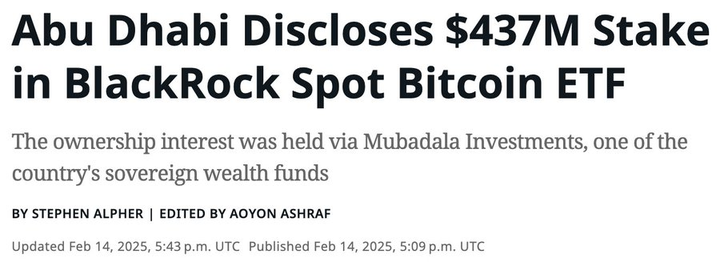
With this in mind, the median Bitcoin holdings of all institutions in these 13F filings are only 0.13%.
This ratio is very small...but it is a positive signal. This shows that Bitcoin adoption in institutions is still in a very early stage. It is worth reminding that BlackRock recently recommended 1-2% of its assets to Bitcoin.
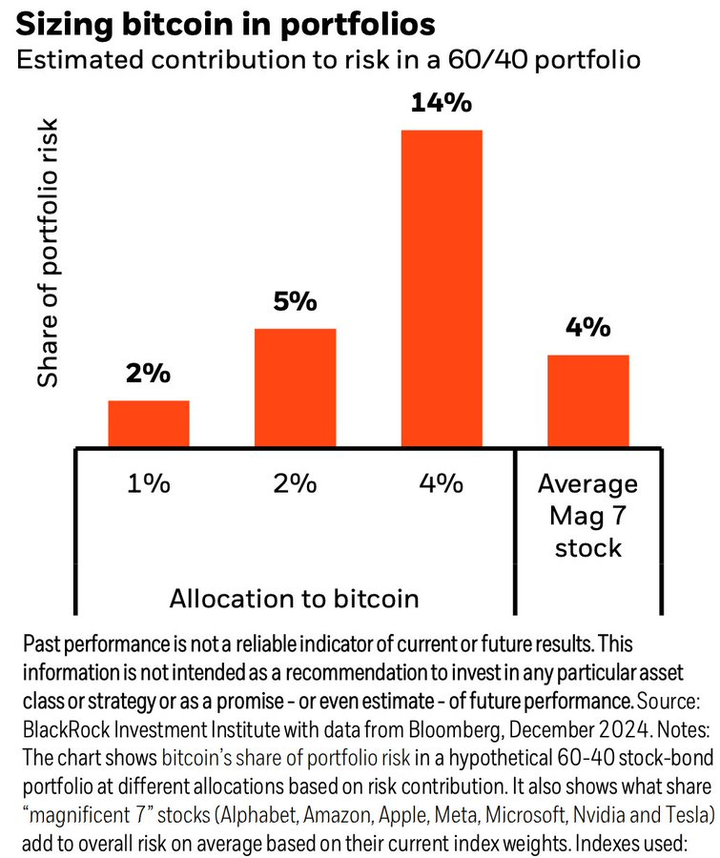
However, among these investment companies, a few institutions have significantly higher Bitcoin allocation ratios than their peers. Coincidentally, their managers are all top asset management experts in the industry and have proven outstanding investment performance.
2. Information worth paying attention to
Here are some of the most eye-catching 13F filings that are particularly worthy of attention…

- Horizon Kinetics
Horizon Kinetics' second largest holding is Bitcoin (16.16%), with an exposure of approximately $1.3 billion. The company is led by Murray Stahl, one of the most outstanding figures in the investment world. In its Q4 2024 review, the company explained why they did not rebalance their Bitcoin positions.
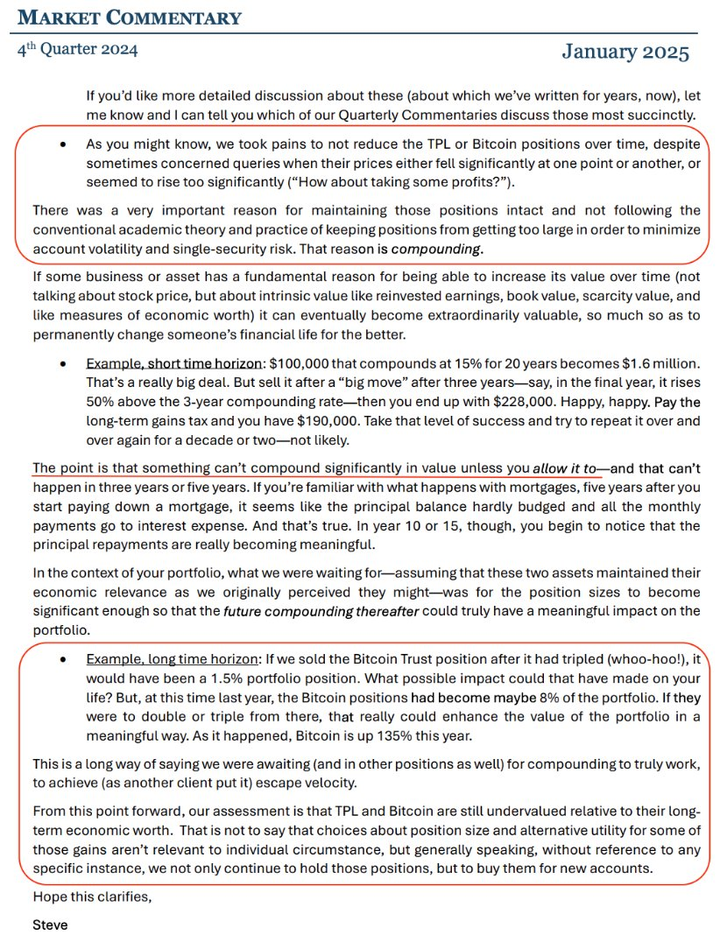
- Bracebridge Capital
The company's largest holdings are Bitcoin (23.6%), with an exposure of approximately $334 million.
Leaded by Nancy Zimmerman, Bracebridge Capital specializes in managing assets for foundations, pensions, high net worth individuals (HNWIs), and manages some of the portfolios of Yale and Princeton University, two of the best-performing endowments in the past 20 years.
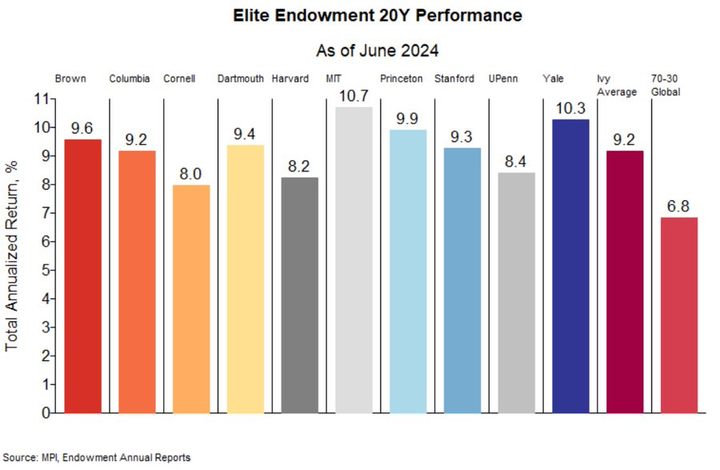
- Tudor Investment Corp
Tudor's largest holding is Bitcoin (1.625%), with an exposure of approximately US$436 million. This declaration made some headlines and is indeed worth paying attention to.
Paul Tudor Jones is one of the greatest investors of this generation. Last month, he also talked about why he still holds Bitcoin.
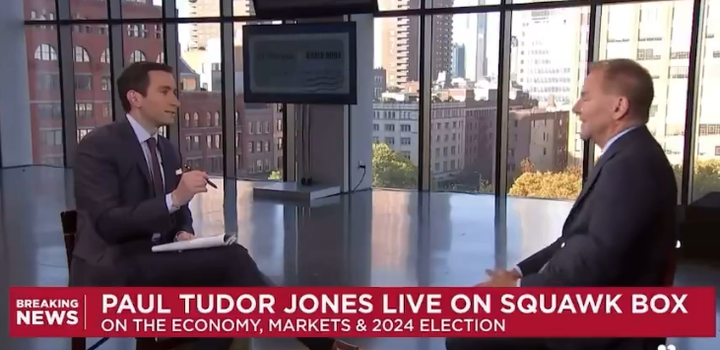
- Fortress Investment Group's fourth largest position is Bitcoin (11.2%), with an exposure of approximately US$70 million. It is worth noting that Abu Dhabi Sovereign Wealth Fund (Mubadala) acquired 68% of Fortress's shares last year and became its controlling shareholder.
So, in fact, this is just a further layout of the UAE on Bitcoin.

- Brevan Howard
The company's second largest holding is Bitcoin (8.74%), with an exposure of approximately $1.4 billion. Brevan Howard’s team has been a staunch supporter of Bitcoin for years, and the large macro hedge fund is clearly versed in the art of long-term holding (HODLing).
Bitcoin plummeted 50% in the 2022 bear market, but billionaire Alan Howard still expressed a firm view...
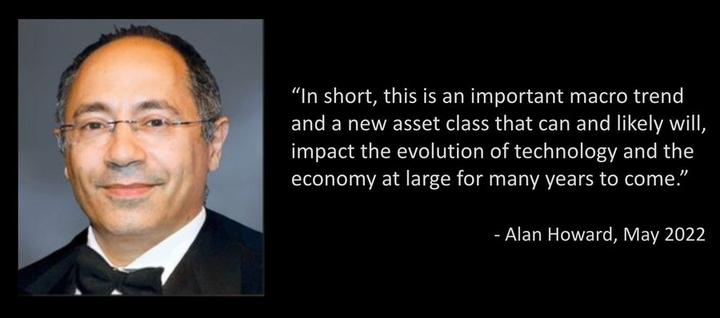
- Discovery Capital Management
The company's fifth largest holding is Bitcoin (4.6%), with an exposure of approximately $68 million. Discovery is led by Robert Citrone, who worked with Julian Robertson and George Soros and is a minority shareholder of the Pittsburgh Steelers.
He once explained why he was concerned about Bitcoin.
- Jericho Capital
The company's fifth largest holding is Bitcoin (5.4%), with an exposure of approximately $378 million. Jericho is led by Josh Resnick, and the fund's growth trajectory is quite impressive – from $36 million in 2009 to more than $7 billion in assets under management today.
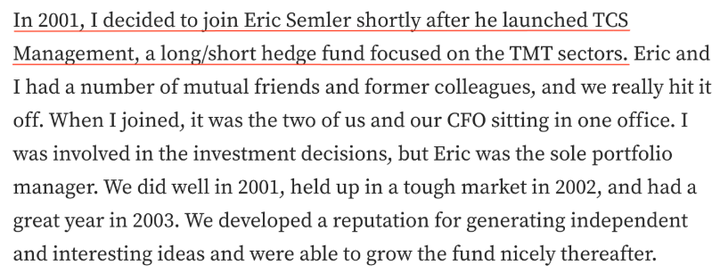
- Hudson Bay Capital Management
The company holds a 0.15% position in Bitcoin and has an exposure of approximately $44 million. But the real interesting thing is not this position, but the infamous Bitcoin short Nouriel Roubini turned out to be a senior consultant to the company.
Fortunately, they didn't listen to his Bitcoin advice!

- The big news here on the State of Wisconsin Investment Board is that the state's pension funds have more than tripled in the final quarter.
Q2: Holding $99 million, 2,898,051 shares (0.26%)
Q3: Holdings of US$104 million, 2,889,251 shares (0.26%)
Q4: Holdings of US$321 million, 6,060,351 shares (0.82%)
Increase the position winner!

- State of Michigan Retirement System
But Wisconsin is not the only state to increase its holdings of Bitcoin—Michigan’s pension fund has almost doubled its Bitcoin holdings.
Q2: Holding US$6.6 million, 110,000 shares (0.03%)
Q3: Holding $6.9 million, 110,000 shares (0.03%)
Q4: Holding $9.3 million, 100,000 shares (0.05%)
The scale is still small, but it is growing!
- Emory University
The university's second largest holding is Bitcoin (32.3%), with an exposure of approximately $22 million. The endowment's Bitcoin holdings remain unchanged from last quarter, meaning that despite the price of Bitcoin rising by about 50%, they did not actively adjust their holdings.
Emory University chooses to continue holding (HODL).

- Pine Ridge Advisors
The company's second largest holding is Bitcoin (18.4%), with an exposure of approximately $209 million. I don't know much about this company, but the reason I mention it is because for a family office of this size, its Bitcoin configuration ratio is quite concentrated.
By the way, this is their entire official website interface – so you know they are indeed "regular troops".

- Capula Management
The company's second largest holding is Bitcoin (5.4%), with an exposure of approximately $936 million. The fourth largest hedge fund in Europe is led by Yan Huo, who was the former head of JPMorgan’s fixed income trading division.
Their investment strategy is innovative and low-relevant investment, no wonder they are long for Bitcoin.
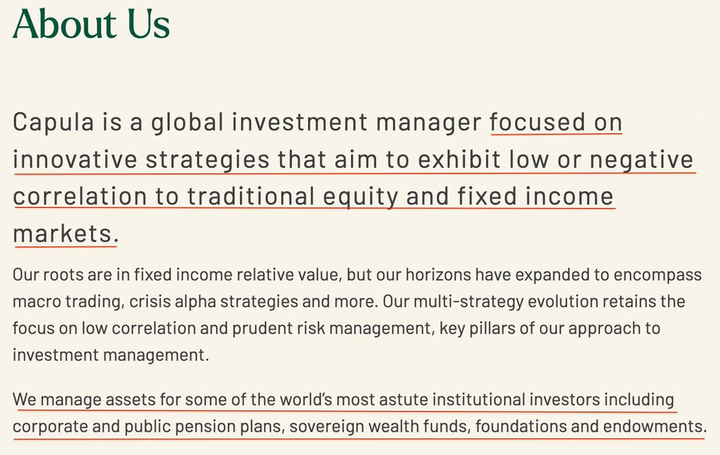
- Cresset Asset Management
Bitcoin has become one of the largest independent registered investment advisors (RIAs) in the United States, Cresset, one of the largest and leading independent registered investment advisors (RIAs). Cresset is increasing its Bitcoin holdings every quarter:
Q2: Holdings of US$33.7 million (0.14%)
Q3: Holdings of US$53.9 million (0.21%)
Q4: Holdings of US$107.5 million (0.51%)
This is worth paying attention to to measure the investment trends of its financial adviser (FA) in Bitcoin.

You may have noticed that I have not mentioned some well-known institutions that hold large numbers of Bitcoin ETFs, such as:
Millennium (USD 2.6 billion, 1.28%)
Jane Street ($2.4 billion, 0.52%)
Susquehanna ($1 billion, 0.16%)
DE Shaw (USD 869 million, 0.64%)
Citadel (USD 446 million, 0.08%)
Point72 (USD 155 million, 0.34%)
This is because these institutions are mainly quantitative funds and market makers. Their algorithms do not care about what the transaction is, whether it is IBIT, META, GE, SPY or TLT, they are just looking for arbitrage opportunities and market inefficiency.
So they are not long-term holders, and I speculate that many institutions' bitcoin positions may be market neutral (net-neutral), which makes their exposure less interesting to me.
Having said that, I still appreciate their trading activity in the market. Their participation improves market efficiency and makes the market run smoother by narrowing the bid-ask spread, deepening the order book, and improving liquidity.
The same situation applies to some large banks holding Bitcoin ETFs:
JPMorgan: $964,000 (0.0001%)
Goldman Sachs: US$2.3 billion (0.37%)
Wells Fargo: $375,000 (0.0001%)
Bank of America: $24 million (0.002%)
Morgan Stanley: $259 million (0.02%)
Banks such as JPMorgan Chase are authorized participants (APs) of many Bitcoin ETFs, and also assume the role of market makers. It is completely normal for APs to hold a portion of the ETF share on the balance sheet, as they are responsible for creating and redeeming ETF shares.
Market makers also need to hold a certain amount of ETF shares in order to better provide liquidity, promote market trading, improve pricing efficiency, and ensure the accuracy of ETF prices.
In addition, banks are currently subject to regulatory restrictions by the Federal Reserve, prohibiting holding Bitcoin on their own balance sheets in a self-operated manner. For specific regulations, please refer to this official document: Federal Reserve Statement.
However, with the revocation of SAB-121 regulations, the regulatory environment is changing. Among these banks, Morgan Stanley is the most prominent—in August last year, it became the first large bank to allow financial advisers to recommend Bitcoin ETFs to clients.
Goldman Sachs has also been active, providing Bitcoin exposure to high-net-worth clients through its asset management division for many years. But if its trading department holds Bitcoin, I guess it is more likely to be running a market neutral arbitrage strategy (such as basis trading), that is, it is not a true net long.
As bank regulation evolves, how these large banks adjust their Bitcoin positions and expand their participation in the Bitcoin market in the coming quarters will be a trend worth paying close attention to.
This is worth paying attention to.
3. Summary
Overall, these 13F declaration documents show that Bitcoin is gradually becoming an institutional-level asset. At present, Bitcoin's market size and liquidity are already large enough to accommodate these institutional investors.
With new investment tools being introduced, these institutions will have more ways to gain Bitcoin exposure, and institutional adoption will accelerate.
I’ve covered some of the pioneers in the entry into Bitcoin in this post, but this trend is still in its very early stages, which means there are still huge opportunities in the future.
The institutional investors who manage trillions of dollars are still just a simple experience and have just begun to enter the Bitcoin market. According to my research: Of the 8,190 13F filings in the last quarter, only about 19% of institutions disclosed their long positions in Bitcoin. As more institutions enter the market, or existing institutions increase allocation, the inflow of funds in Bitcoin will drive its prices to rise and even completely change its investor structure.



 chaincatcher
chaincatcher